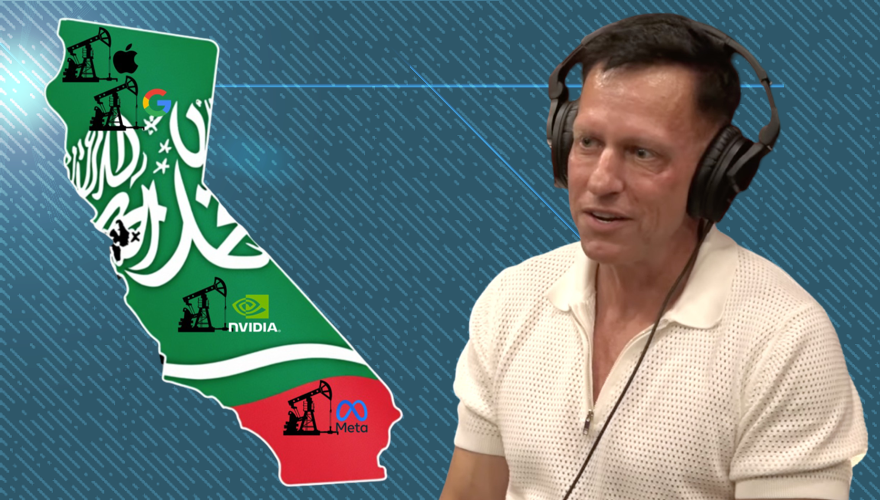Billionaire entrepreneur Peter Thiel compared California to Saudi Arabia to explain how the state thrives despite widespread criticism of its governance.
“The crazy thing about California is, there’s always sort of a right-wing or libertarian critique of California that it’s such a ridiculous place it should just collapse under its own ridiculousness, and it doesn’t quite happen,” he said during a recent appearance on The Joe Rogan Experience.
Thiel, whose net worth is over $11 billion, is the co-founder of PayPal, an early investor in Facebook, and the founder of big data analytics company Palantir Technologies.
“The macroeconomics … are pretty good,” said Thiel, a longtime resident of California. “Forty million people. The GDP’s around $4 trillion. It’s about the same as Germany with 80 million or Japan with 125 million. Japan has three times the population of California, same GDP means one-third the per capita GDP.”
“So, there’s some level on which California as a whole is working, even though it doesn’t work from a governance point-of-view, it doesn’t work for a lot of the people who live there,” he said.
Thiel then compared the Golden State to Saudi Arabia, which has the world’s second-largest proven oil reserves.
“California is … kind of like Saudi Arabia. You have a crazy religion – Woke-ism in California, Wahhabism in Saudi Arabia – you know, not that many people believe it, but it distorts everything,” he continued. “And then you have oil fields in Saudi Arabia and you have the big tech companies in California. And the oil pays for everything, and then you have a completely bloated, inefficient government sector, and you have … all sorts of distortions in the real estate market where people also make lots of money, sort of the government and real estate are ways you redistribute the oil wealth or the big tech money in California.”
He added: “It’s not the way you might want to design a system from scratch, but it’s pretty stable. People have been saying Saudi Arabia is ridiculous, it’s gonna collapse any year now, they’ve been saying that for 40 or 50 years. But if you have a giant oil field, you can pay for a lot of ridiculousness. I think that’s the way you have to think of California.” 🚨 Peter Thiel compares California to Saudi Arabia: “They have oil. California has tech. Both have crazy religions. Wokism and Wahhabism. Not that many people believe it, and it distorts everything.” pic.twitter.com/yT6LDORsRl
— Gene Mikhov (@genegmb) August 17, 2024
“There are things about it that are ridiculous, but there’s something about that it doesn’t naturally self-destruct overnight,” Thiel said.
“There’s a lot of kick-ass people there,” said Rogan, who relocated from Los Angeles to Austin during the pandemic. “And there’s a lot of people that are still generating enormous amounts of wealth there. And it’s too difficult to just pack up and leave.”
“It’s something like four of the eight or nine companies with market capitalizations over a trillion dollars are based in California,” Thiel interjected. “It’s Google, Apple, now Nvidia, Meta, I think Broadcom’s close to that.”
According to the state’s 2024-25 budget report, California faces a $68 billion deficit resulting from “a severe revenue decline in 2022-23.”
The report states:Given the state faces a serious budget problem, using general purpose reserves this year is merited. That said, we suggest the Legislature exercise some caution when deploying tools like reserves and cost shifts. The state’s reserves are unlikely to be sufficient to cover the state’s multiyear deficits—which average $30 billion per year under our estimates. These deficits likely necessitate ongoing spending reductions, revenue increases, or both. As a result, preserving a substantial portion—potentially up to half—of reserves would provide a helpful cushion in light of the anticipated shortfalls that lie ahead.
California has also been the subject of a sharp critique of its fledgling efforts to build a high-speed rail.
“New cost figures issued in an update report from the California High-Speed Rail Authority show that the plan to build the 171-mile initial segment has shot up to a high of $35 billion, exceeding secured funding by $10 billion,” reports CalMatters. “The cost of that partial system is now higher than the $33 billion estimate for the entire 500-mile Los Angeles to San Francisco system when voters approved a bond in 2008.”

